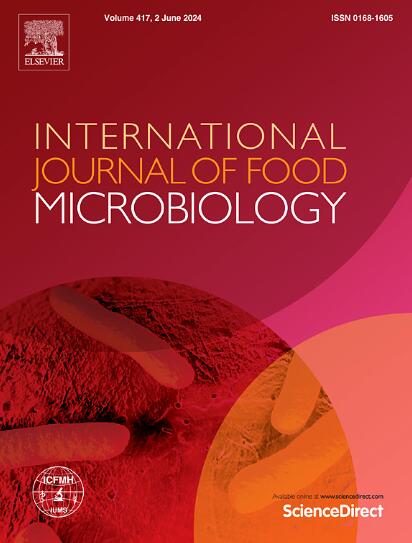产碳青霉烯酶细菌在零售虾中意外的高流行率和blandm -1阳性希瓦氏菌的广泛传播
IF 5.2
1区 农林科学
Q1 FOOD SCIENCE & TECHNOLOGY
International journal of food microbiology
Pub Date : 2025-05-29
DOI:10.1016/j.ijfoodmicro.2025.111284
引用次数: 0
摘要
由于产生碳青霉烯酶的病原体,特别是产生新德里金属β-内酰胺酶(NDM)的细菌的传播,碳青霉烯类抗生素作为关键的最后手段越来越无效。尽管NDM已在各种环境和临床来源中被检测到,但尽管虾是一种广泛食用的食物,但其在海鲜,特别是虾中的流行程度仍未得到充分研究。本研究旨在了解产ndm细菌在对虾中的流行情况及分子特性。从8个农贸市场采集非重复虾类样本77只,检测产生ndm的细菌。其中,从34份样品中分离出38株blandm阳性菌株(44.2%,34/77),并进行了全基因组测序(WGS)。MALDI-TOF和WGS鉴定这些分离株为希瓦氏菌属(S. indica, n = 9;儿童链球菌,n = 12;藻类s.s ., n = 6),河流弧菌(n = 6)和大肠杆菌(n = 5),其中s.s spp.和河流弧菌表现出高度的遗传同质性,表明在对虾中存在局部克隆传播。对随机选取的11株菌株进行纳米孔测序和分子表征,发现10个blaNDM基因位于质粒上,包括来自S. algae和V. furnisii的IncC (n = 2)、来自Shewanella spp.的无法分型的质粒(n = 5),以及来自E. coli的IncI1、IncHI2和IncFII-FIA质粒。这些质粒与GenBank中储存的其他来源的质粒具有高度同源性,并且无法分型的质粒是希瓦氏菌特有的。据我们所知,这项研究首次报道了虾中blaNDM阳性病原体的高流行率,突出了blaNDM通过质粒广泛传播和在海产品中的克隆传播对公共卫生构成的严重威胁。越来越多的证据表明,迫切需要制定严格的食品安全政策和法规,以应对新出现的食品污染物带来的健康风险。本文章由计算机程序翻译,如有差异,请以英文原文为准。
Unexpected high prevalence of carbapenemase-producing bacteria and widely spread of blaNDM-1-positive Shewanella spp. in retail shrimp
Carbapenems, critical last-resort antibiotics, are increasingly ineffective due to the spread of carbapenemase-producing pathogens, particularly New Delhi metallo-β-lactamase (NDM)-producing bacteria. Although NDM has been detected in a variety of environmental and clinical sources, its prevalence in seafood, especially shrimp, remains underexplored despite shrimp being a widely consumed food. This study aimed to investigate the prevalence and molecular characteristics of NDM-producing bacteria in shrimp. A total of 77 non-repetitive shrimp samples were collected from 8 farmers' markets to detect NDM-producing bacteria. Among these, 38 blaNDM-positive isolates were recovered from 34 samples (44.2 %, 34/77) and subject to whole genome sequencing (WGS). MALDI-TOF and WGS showed that these isolates were identified as Shewanella spp. (S. indica, n = 9; S. chilikensis, n = 12; S. algae, n = 6), Vibrio fluvialis (n = 6), and Escherichia coli (n = 5), with S. spp. and V. fluvialis exhibiting high genetic homogeneity, suggesting localized clonal spread among shrimps. Further Nanopore sequencing and molecular characterization of 11 randomly selected isolates indicated that ten blaNDM genes were located on plasmids, including IncC (n = 2, from S. algae and V. furnissii), untypeable plasmids from Shewanella spp. (n = 5), and IncI1, IncHI2, and IncFII-FIA plasmids from E. coli. These plasmids exhibited high homology with those from other sources deposited in GenBank, and the untypeable plasmids were unique to Shewanella spp. This study, to the best of our knowledge, represents the first report of the high prevalence of blaNDM-positive pathogens in shrimp, highlighting the critical public health threat posed by the widespread propagation of blaNDM through plasmids and clonal transmission in seafood. This study contributes to the growing body of evidence highlighting the critical need for stringent food safety policies and regulations to combat the health risks posed by emerging food pollutants.
求助全文
通过发布文献求助,成功后即可免费获取论文全文。
去求助
来源期刊
CiteScore
10.40
自引率
5.60%
发文量
322
审稿时长
65 days
期刊介绍:
The International Journal of Food Microbiology publishes papers dealing with all aspects of food microbiology. Articles must present information that is novel, has high impact and interest, and is of high scientific quality. They should provide scientific or technological advancement in the specific field of interest of the journal and enhance its strong international reputation. Preliminary or confirmatory results as well as contributions not strictly related to food microbiology will not be considered for publication.

 求助内容:
求助内容: 应助结果提醒方式:
应助结果提醒方式:


